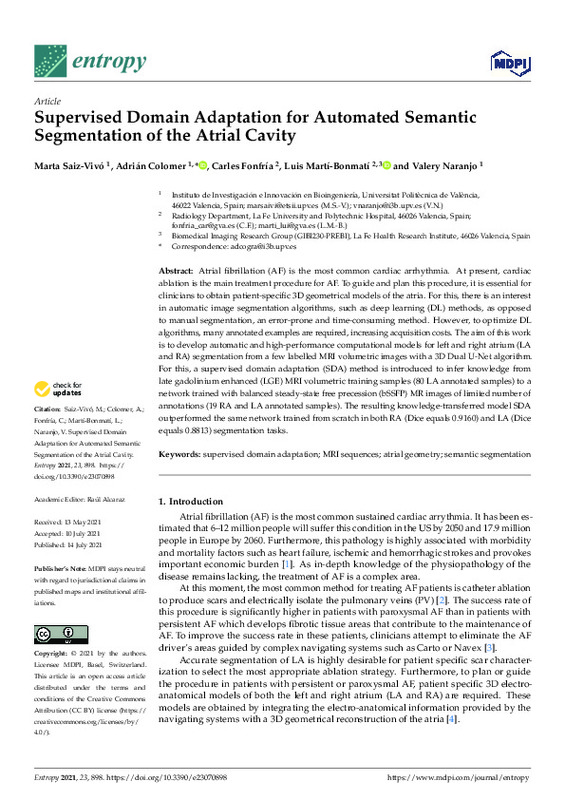JavaScript is disabled for your browser. Some features of this site may not work without it.
Buscar en RiuNet
Listar
Mi cuenta
Estadísticas
Ayuda RiuNet
Admin. UPV
Supervised Domain Adaptation for Automated Semantic Segmentation of the Atrial Cavity
Mostrar el registro sencillo del ítem
Ficheros en el ítem
| dc.contributor.author | Saiz-Vivó, Marta
|
es_ES |
| dc.contributor.author | Colomer, Adrián
|
es_ES |
| dc.contributor.author | Fonfría, Carles
|
es_ES |
| dc.contributor.author | Martí-Bonmatí, Luis
|
es_ES |
| dc.contributor.author | Naranjo Ornedo, Valeriana
|
es_ES |
| dc.date.accessioned | 2022-01-30T19:06:20Z | |
| dc.date.available | 2022-01-30T19:06:20Z | |
| dc.date.issued | 2021-07 | es_ES |
| dc.identifier.issn | 1099-4300 | es_ES |
| dc.identifier.uri | http://hdl.handle.net/10251/180362 | |
| dc.description.abstract | [EN] Atrial fibrillation (AF) is the most common cardiac arrhythmia. At present, cardiac ablation is the main treatment procedure for AF. To guide and plan this procedure, it is essential for clinicians to obtain patient-specific 3D geometrical models of the atria. For this, there is an interest in automatic image segmentation algorithms, such as deep learning (DL) methods, as opposed to manual segmentation, an error-prone and time-consuming method. However, to optimize DL algorithms, many annotated examples are required, increasing acquisition costs. The aim of this work is to develop automatic and high-performance computational models for left and right atrium (LA and RA) segmentation from a few labelled MRI volumetric images with a 3D Dual U-Net algorithm. For this, a supervised domain adaptation (SDA) method is introduced to infer knowledge from late gadolinium enhanced (LGE) MRI volumetric training samples (80 LA annotated samples) to a network trained with balanced steady-state free precession (bSSFP) MR images of limited number of annotations (19 RA and LA annotated samples). The resulting knowledge-transferred model SDA outperformed the same network trained from scratch in both RA (Dice equals 0.9160) and LA (Dice equals 0.8813) segmentation tasks. | es_ES |
| dc.description.sponsorship | This work has been supported by the GVA through project PROMETEO/2019/109. The equipment used for this research has been funded by the European Union within the operating Program ERDF of the Valencian Community 2014-2020 with the grant number IDIFEDER/2020/030. | es_ES |
| dc.language | Inglés | es_ES |
| dc.publisher | MDPI AG | es_ES |
| dc.relation.ispartof | Entropy | es_ES |
| dc.rights | Reconocimiento (by) | es_ES |
| dc.subject | Supervised domain adaptation | es_ES |
| dc.subject | MRI sequences | es_ES |
| dc.subject | Atrial geometry | es_ES |
| dc.subject | Semantic segmentation | es_ES |
| dc.subject.classification | TEORIA DE LA SEÑAL Y COMUNICACIONES | es_ES |
| dc.title | Supervised Domain Adaptation for Automated Semantic Segmentation of the Atrial Cavity | es_ES |
| dc.type | Artículo | es_ES |
| dc.identifier.doi | 10.3390/e23070898 | es_ES |
| dc.relation.projectID | info:eu-repo/grantAgreement/GVA//IDIFEDER%2F2020%2F030/ | es_ES |
| dc.relation.projectID | info:eu-repo/grantAgreement/GVA//PROMETEO%2F2019%2F109//COMUNICACION Y COMPUTACION INTELIGENTES Y SOCIALES/ | es_ES |
| dc.rights.accessRights | Abierto | es_ES |
| dc.contributor.affiliation | Universitat Politècnica de València. Departamento de Comunicaciones - Departament de Comunicacions | es_ES |
| dc.description.bibliographicCitation | Saiz-Vivó, M.; Colomer, A.; Fonfría, C.; Martí-Bonmatí, L.; Naranjo Ornedo, V. (2021). Supervised Domain Adaptation for Automated Semantic Segmentation of the Atrial Cavity. Entropy. 23(7):1-16. https://doi.org/10.3390/e23070898 | es_ES |
| dc.description.accrualMethod | S | es_ES |
| dc.relation.publisherversion | https://doi.org/10.3390/e23070898 | es_ES |
| dc.description.upvformatpinicio | 1 | es_ES |
| dc.description.upvformatpfin | 16 | es_ES |
| dc.type.version | info:eu-repo/semantics/publishedVersion | es_ES |
| dc.description.volume | 23 | es_ES |
| dc.description.issue | 7 | es_ES |
| dc.relation.pasarela | S\444799 | es_ES |
| dc.contributor.funder | Generalitat Valenciana | es_ES |
| dc.contributor.funder | European Regional Development Fund | es_ES |








